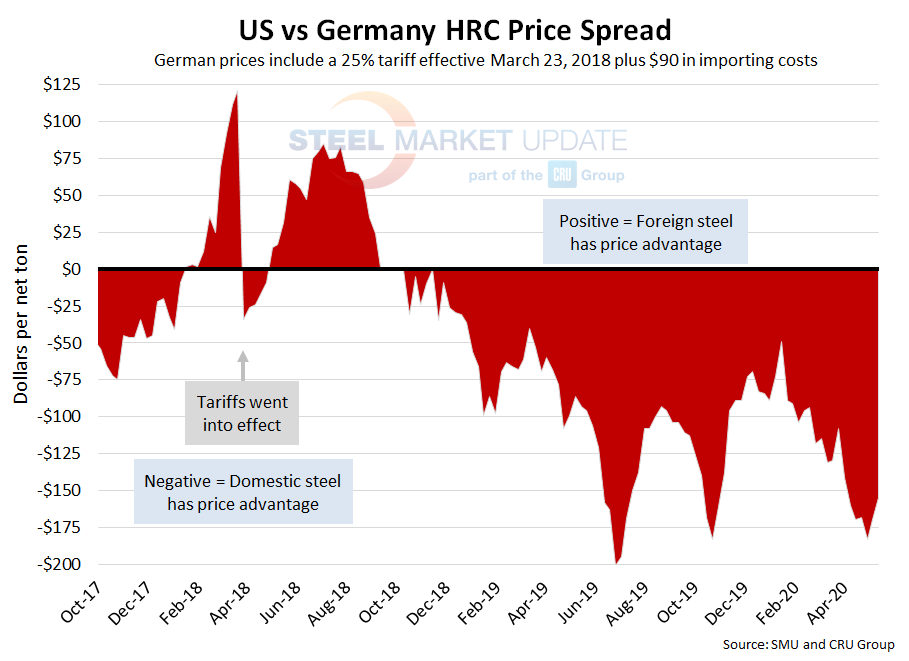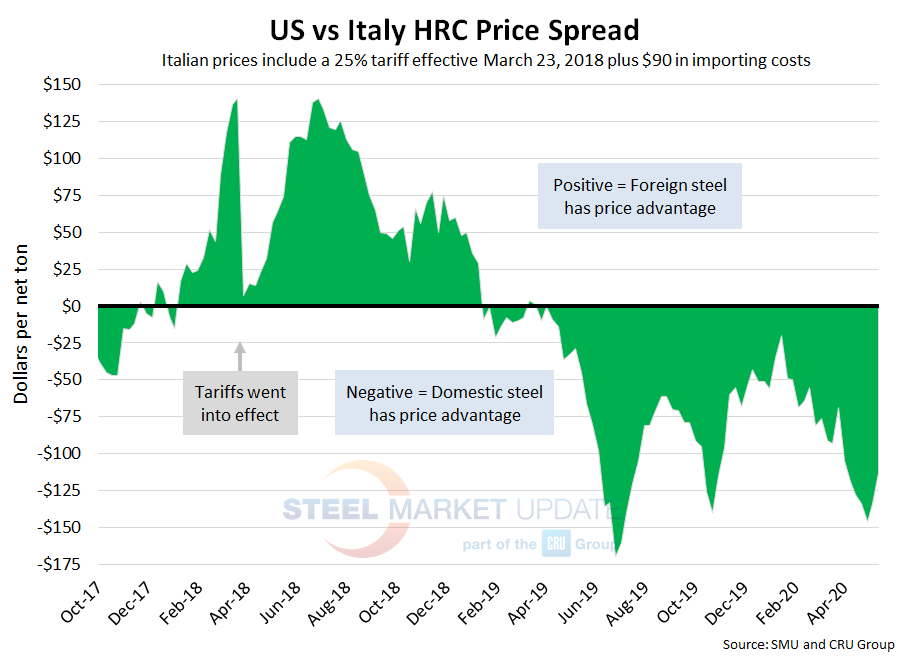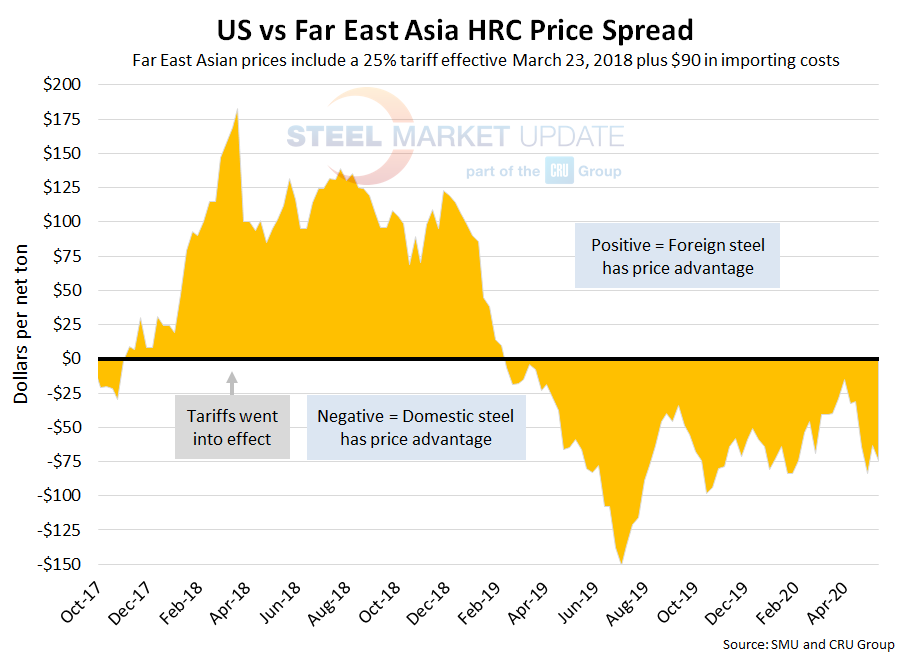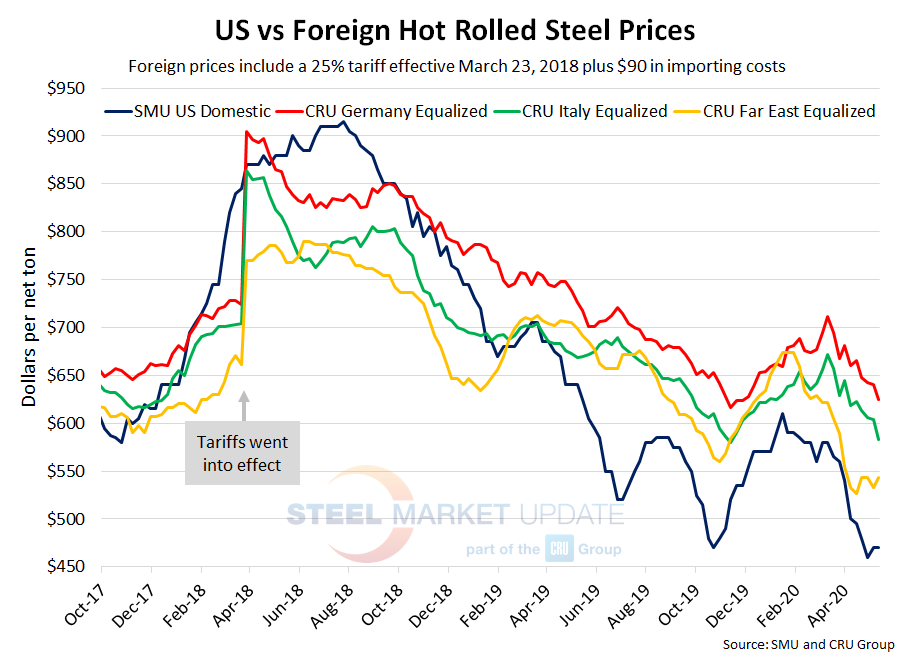International Steel Prices

Foreign vs. Domestic Hot Rolled Steel Prices
Written by Brett Linton
May 14, 2020
This week’s SMU comparison of foreign and domestic hot rolled prices shows that U.S prices remain advantageous over foreign imports, albeit slightly less so than late-April figures, according to SMU and CRU indices. The price gap between domestic HRC compared to German and Italian imports remains over $100 per ton, as has been the case over the past few months. The East/Southeast Asian price has hovered around $60-80 per ton higher than domestic prices for the last four weeks.
The following calculation is used by Steel Market Update to identify the theoretical spread between foreign hot rolled steel prices (delivered to U.S. ports) and domestic hot rolled coil prices (FOB domestic mills). This is only a “theoretical” calculation as freight costs, trader margin and other costs can fluctuate, ultimately influencing the true market spread. We are comparing the SMU U.S. hot rolled weekly index to CRU hot rolled weekly indices for Germany, Italy and the Far East (East and Southeast Asian port).
![]() SMU includes a 25 percent import tariff effective on foreign prices after March 23, 2018. We then add $90 per ton to the foreign prices in consideration of freight costs, handling, trader margin, etc., to provide an approximate “CIF U.S. ports price” that can be compared against the SMU U.S. hot rolled price. Note that we do not include any antidumping (AD) or countervailing duties (CVD) in this analysis.
SMU includes a 25 percent import tariff effective on foreign prices after March 23, 2018. We then add $90 per ton to the foreign prices in consideration of freight costs, handling, trader margin, etc., to provide an approximate “CIF U.S. ports price” that can be compared against the SMU U.S. hot rolled price. Note that we do not include any antidumping (AD) or countervailing duties (CVD) in this analysis.
German HRC
As of Wednesday, May 13, the CRU German HRC price was $428 per net ton, down $12 over the previous week, and down $14 from two weeks prior. Adding tariffs and import costs, that puts the German price at $625 per ton delivered to the U.S. The latest SMU hot rolled price average is $470 per ton, unchanged over last week and up $10 over two weeks prior. Therefore, domestically sourced HRC is theoretically $155 per ton cheaper than imported German HRC; the spread was $170 last week and $183 two weeks ago. U.S. prices have held this price advantage for over 16 consecutive months.

Italian HRC
CRU published Italian HRC prices at $394 per net ton, down $17 from last week and down $19 over two weeks ago. After adding tariffs and import costs, the delivered price of Italian HRC is approximately $583 per ton. Accordingly, domestic HRC is theoretically $113 per ton cheaper than imported Italian HRC; the spread was $134 the previous week and $146 two weeks prior. U.S. prices have held this price advantage for over one year.

Far East Asian HRC
The CRU Far East Asian HRC price rose $9 per ton over last week at $363 per net ton, unchanged over two weeks ago. Adding tariffs and import costs, the delivered price of Far East Asian HRC to the U.S. is $544 per ton. Therefore, U.S.-produced HRC is theoretically $74 per ton cheaper than imported Far East Asian HRC; the spread was $63 last week and $84 two weeks ago. Domestic prices have held this price advantage for 15 consecutive months.

The graph below compares all four price indices and highlights the effective date of the tariffs. Foreign prices are referred to as “equalized,” meaning they have been adjusted to include tariffs and importing costs for a like-for-like comparison against the U.S. price.

Note: Freight is an important part of the final determination on whether to import foreign steel or buy from a domestic mill supplier. Domestic prices are referenced as FOB the producing mill, while foreign prices are FOB the Port (Houston, NOLA, Savannah, Los Angeles, Camden, etc.). Inland freight, from either a domestic mill or from the port, can dramatically impact the competitiveness of both domestic and foreign steel. When considering lead times, a buyer must take into consideration the momentum of pricing both domestically and in the world markets. In most circumstances (but not all), domestic steel will deliver faster than foreign steel ordered on the same day.

Brett Linton
Read more from Brett LintonLatest in International Steel Prices

US and offshore HRC prices tick lower
The threat of tariffs over the past two months has been a springboard for US prices. But the Section 232 reinstatement on March 13 narrowed the domestic premium over imports on a landed basis.

Domestic CRC prices surge ahead of imports
The price spread between stateside-produced CR and imports reached its widest margin in over a year.

US HR prices rising faster than offshore tags
Hot-rolled (HR) coil prices continued to rally in the US this week, quickly outpacing price gains seen abroad. The result: US hot band prices have grown widely more expensive than imports on a landed basis. The premium US HR tags carry over HR prices abroad now stands at a 14-month high. SMU’s average domestic HR […]

US HR price premium over imports widens
Hot-rolled (HR) coil prices were flat in the US this week, while tags in offshore markets were mostly down.

US HR price premium over imports edges up
The price premium between stateside hot band and landed imports widened slightly this week.
